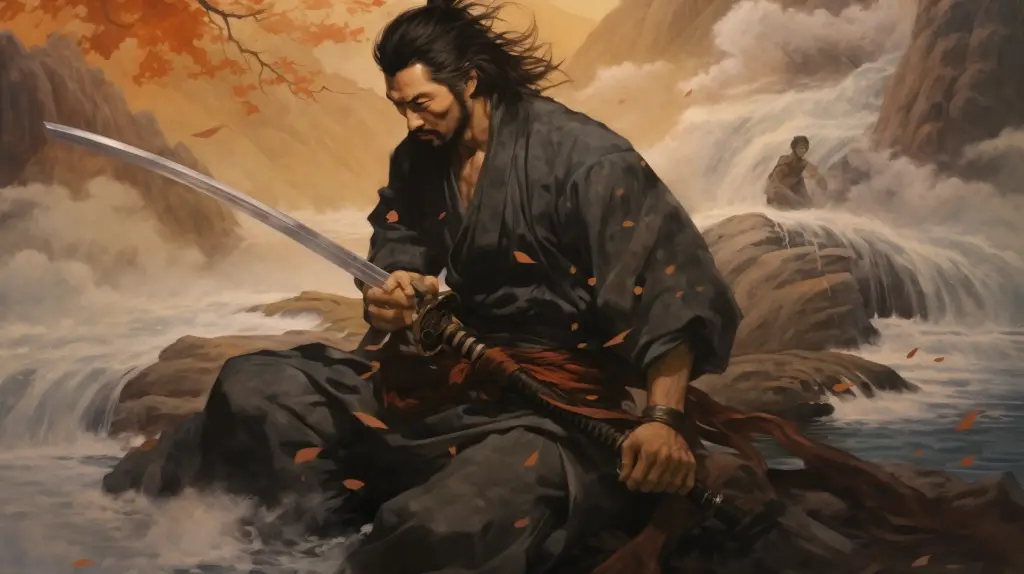Miyamoto Musashi, also known as Shinmen Takezo, Miyamoto Bennosuke, or simply Musashi, remains an enduring figure in samurai history, largely due to his unique approach to combat and strategy, as expressed in his influential work, ‘The Book of Five Rings.’ The legendary swordsman is often imagined with his iconic weapon, the katana. To truly appreciate the importance of Musashi’s katana, one must understand its cultural significance, the man who wielded it, and the innovative techniques he introduced.
The Symbol of the Samurai: The Katana
The katana is an integral part of Japan’s cultural and martial heritage. This traditional Japanese sword, characterized by a curved, slender, single-edged blade with a circular or squared guard and a long grip to accommodate two hands, embodies the spirit of the samurai, representing their honor, discipline, and martial prowess.
The creation process of a traditional katana is meticulous and sacred, involving several weeks or even months of intense labor. Swordsmiths employ a variety of specialized techniques, including folding the steel numerous times to increase its strength and flexibility. The result is a highly efficient cutting weapon, resilient yet flexible, which exemplifies the harmony of form and function.
Miyamoto Musashi: The Sword-Saint
Born in 1584, Miyamoto Musashi became one of the most renowned swordsmen in Japanese history. His life was a continuous journey of martial exploration, honing his skills through numerous duels and developing a unique dual-sword technique known as Niten Ichi-ryu.
His signature weapon, the katana, was an extension of his spirit and philosophy. But Musashi was not confined to conventional wisdom; he deviated from the standard approach to the sword. Instead of using it as a tool of blind destruction, he regarded it as a means of understanding the deeper aspects of life and the self.
READ MORE: The Legendary Katana of Miyamoto Musashi: A Story of Skill and Spirit
Innovations and Techniques: The Niten Ichi-ryu
Miyamoto Musashi’s most significant contribution to samurai swordsmanship was arguably the Niten Ichi-ryu (Two Heavens as One) style, where he simultaneously wielded a katana and a shorter sword (wakizashi). This dual-sword technique was unconventional and counter-intuitive in an era where the dominant martial doctrine emphasized mastering the katana with both hands for maximum power and control.
This style allowed Musashi to engage multiple adversaries effectively, block and attack simultaneously, and create a psychological advantage through unpredictable movements. His skill in implementing this technique was testament to his mastery over his weapon.
READ MORE: Japanese concepts and terms in ‘Musashi – Book 1: The Way of the Samurai’
The Spirit of Musashi’s Katana
The essence of Musashi’s katana cannot be disconnected from the philosophical and spiritual underpinnings of his life. His book, ‘The Book of Five Rings,’ elucidates his understanding of strategy, combat, and life itself. His teachings do not focus solely on winning duels but on pursuing a path of constant self-improvement and understanding the nature of conflict.
In this light, the katana was not merely a weapon for Musashi but a tool of introspection and enlightenment. Each swing embodied his quest for perfection, each duel was a mirror into his soul, and every victory was a step towards attaining inner peace and harmony.
READ MORE: List of main characters in ‘Musashi – Book 1: The Way of the Samurai’
Conclusion
The katana of Miyamoto Musashi carries the weight of the samurai’s legendary skill and philosophy. It is a symbol of his unorthodox approach to combat, his deep spiritual understanding, and his relentless pursuit of self-perfection. Above all, it stands testament to his belief that the path of the sword is not merely about conquering opponents but about understanding oneself and the world. To grasp the essence of Musashi’s katana is to touch the heart of the samurai spirit, reminding us that behind every great weapon lies an even greater warrior.



